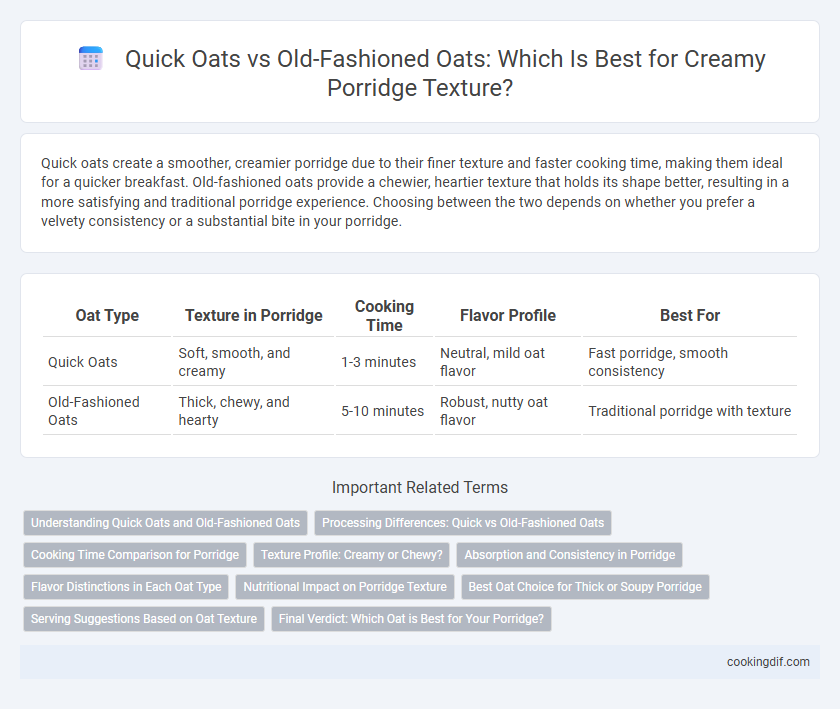Quick oats create a smoother, creamier porridge due to their finer texture and faster cooking time, making them ideal for a quicker breakfast. Old-fashioned oats provide a chewier, heartier texture that holds its shape better, resulting in a more satisfying and traditional porridge experience. Choosing between the two depends on whether you prefer a velvety consistency or a substantial bite in your porridge.
Table of Comparison
| Oat Type | Texture in Porridge | Cooking Time | Flavor Profile | Best For |
|---|---|---|---|---|
| Quick Oats | Soft, smooth, and creamy | 1-3 minutes | Neutral, mild oat flavor | Fast porridge, smooth consistency |
| Old-Fashioned Oats | Thick, chewy, and hearty | 5-10 minutes | Robust, nutty oat flavor | Traditional porridge with texture |
Understanding Quick Oats and Old-Fashioned Oats
Quick oats are rolled thinner and chopped finer than old-fashioned oats, resulting in a softer and creamier porridge texture that cooks faster, typically in about 1 to 3 minutes. Old-fashioned oats retain more structure due to their larger, flatter flakes, creating a chewier and heartier mouthfeel with a cooking time of approximately 5 to 7 minutes. Choosing between quick oats and old-fashioned oats depends on the desired porridge consistency and preparation time, with old-fashioned oats providing a more textured and substantial bowl.
Processing Differences: Quick vs Old-Fashioned Oats
Quick oats undergo a finer milling process and are steamed longer than old-fashioned oats, resulting in a thinner texture that absorbs liquid faster. Old-fashioned oats retain a flatter, thicker flake structure due to minimal processing, providing a chewier, heartier porridge texture. The difference in processing directly affects cooking time and mouthfeel, with quick oats producing a smoother, creamier porridge while old-fashioned oats yield a more substantial and textured bowl.
Cooking Time Comparison for Porridge
Quick oats cook significantly faster, typically requiring only 1 to 3 minutes, making them ideal for a creamy, smooth porridge. Old-fashioned oats take about 5 to 10 minutes to cook, offering a thicker, chewier texture due to their larger, less processed flakes. The choice between quick and old-fashioned oats directly impacts porridge consistency and overall cooking duration.
Texture Profile: Creamy or Chewy?
Quick oats produce a creamier porridge texture due to their finer cut and faster cooking time, allowing the oats to break down more thoroughly. Old-fashioned oats retain a chewier texture because their larger, flatter flakes absorb liquid more slowly and maintain more structure during cooking. The choice between quick oats and old-fashioned oats ultimately determines whether the porridge feels smooth and velvety or robust and textured.
Absorption and Consistency in Porridge
Quick oats absorb water faster than old-fashioned oats, resulting in a smoother and creamier porridge texture. Old-fashioned oats retain more structure during cooking, creating a thicker, chewier consistency with distinct oat flakes. The choice between quick and old-fashioned oats significantly influences the porridge's mouthfeel and viscosity due to differences in their processing and water absorption rates.
Flavor Distinctions in Each Oat Type
Quick oats have a finer texture that breaks down rapidly during cooking, resulting in a smoother, creamier porridge with a mild, slightly sweet flavor. Old-fashioned oats retain more of their shape and offer a chewier bite, contributing to a heartier texture and a nuttier, more robust oat flavor. The choice between these oats depends on desired porridge consistency and the preference for subtle sweetness versus rich, toasted notes.
Nutritional Impact on Porridge Texture
Quick oats have a finer texture and cook faster, creating a smoother, creamier porridge, whereas old-fashioned oats retain more structure, resulting in a chewier, heartier texture. Both types offer similar nutritional profiles rich in fiber, beta-glucans, and essential vitamins, but quick oats may slightly decrease the glycemic index due to faster digestion. The choice between quick and old-fashioned oats ultimately influences the porridge's mouthfeel without significantly altering its nutritional benefits.
Best Oat Choice for Thick or Soupy Porridge
Old-fashioned oats produce a thicker, chewier porridge texture due to their larger, less processed flakes that retain more structure during cooking. Quick oats, being more finely cut and pre-steamed, create a smoother, more soupy consistency ideal for those preferring a creamier bowl. Choosing between old-fashioned and quick oats depends on desired porridge thickness, with old-fashioned oats best for hearty, thick porridge and quick oats suited for lighter, soupier textures.
Serving Suggestions Based on Oat Texture
Quick oats create a smoother, creamier porridge texture ideal for those who prefer a soft, easily digestible meal served with fruit compotes or nut butters. Old-fashioned oats provide a chewier, heartier texture that pairs well with toppings like toasted nuts, seeds, or fresh berries, adding a satisfying bite and enhanced mouthfeel. Choosing the oat type impacts serving suggestions by complementing specific textures and flavor combinations suited to personal preference.
Final Verdict: Which Oat is Best for Your Porridge?
Quick oats create a smoother, creamier porridge texture due to their finer cut and faster cooking time, while old-fashioned oats provide a chewier, heartier bite with more intact structure. Choosing between the two depends on personal preference for texture and cooking speed, with quick oats ideal for a soft, fast breakfast and old-fashioned oats preferred for a robust, traditional porridge. Nutritionally, both offer similar fiber and protein content, making texture and cooking time the key deciding factors.
Quick oats vs old-fashioned oats for porridge texture Infographic

 cookingdif.com
cookingdif.com